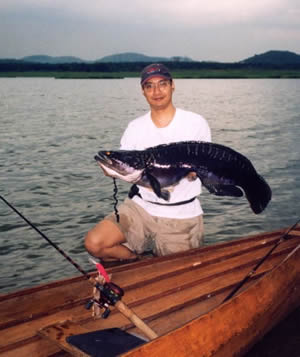
Once in a lifetime
by Christopher S.G. Tan
Big toman! I cannot think of a toman angler I know who does not want to catch a big toman. I myself would certainly want to catch a big toman, but that does not happen often. Even my wife has caught bigger toman than I have. In fact, I think the first time she fished for toman she caught a trophy sized one! It weighed 6.8 kilos, a size I had only dreamed of catching and most certainly a size that many of my fishing friends dreamed of too.
I have heard of the occasional catch that goes into the double digits, but personally do not know of anyone who has succeeded in catching those monsters. Therefore being a realist I felt that to catch a toman in excess of 6 kilos would be very nice; 7 kilos would be a great trophy; 8 kilos would be fantastic and 9 kilos would be incredible!.
Patrick and I had fished the waters south of Klang Valley for toman and haruan for many years. The many ex-tin mine ponds and lakes hold lots of fish, and the toman here tend to be very smart, generally not taking lures, except when we could accurately place the lure very close to its head when it rose before it went back down. Getting the lure to land this close would arouse the toman's aggressive instinct to strike. It is essential to cast rapidly and accurately thus we coined this sort of fishing "quick draw casting" or "shooting from the hip".
The toman we caught ranged from a kilo to maybe 3 kilos, and though it was fun to play with these small toman, once we got the hook up the thrill was not really as big as we would have liked. Then came the little bright idea of dropping down our line class to light lines to spice the fight up. Fishing with light line for toman is not done much, as toman are renowned for their dirty fighting. However in general, these ex-mining ponds do not have many snags. Only once did I get snagged up, a toman wrapped me around an old abandoned gill net (there is no escaping illegal gill nets in our unenforced Malaysian waters).
Following that idea came a brighter idea. If we were going to go with light line fishing, why not do it according to IGFA rules (International Game Fish Association). It had been pointed out to me many times that all the IGFA line classes for toman were caught in Thailand, but where was Malaysia? Did we not have good toman fishing as well? If so, instead of only having Thailand holding all the IGFA line class records for toman (more specifically the snakehead family) we could be patriotic and show the world that "Malaysia Boleh" too.
I was loaned us a high quality scale they had previously used to weigh fish for record submissions. However the scales need to be calibrated and certified correct yearly to be approved for use by IGFA. Fortunately I found a company which could carry out the testing and certification, so that was one hurdle overcome.
The other was to get some good quality line that would test according to IGFA specifications. For a line to qualify for a line class record, it would have to be tested to break at the specified line class or less. For example, to qualify for the 2 kilo line class record, the mainline used should "test" (break) at 2 kilos or less. If it tested even a little over 2 kilos, it would not qualify for the 2 kilo line class. Therefore it would be expedient if we used quality IGFA pre-test line that would ensure we used line that would fall in the line class category we were aiming for. (See what happened to one submission at the end of this article.)
We decided to start out with the 3 kilo line class in our first attempt. So we went about spooling up our favourite reels with the 3 kilo lines and tying the double lines and shock leader lines on.
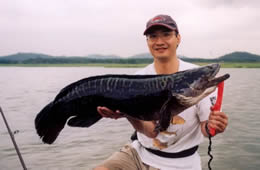 On our first attempt we landed 3 toman. However they were all in the 1 kilo range. The biggest was caught by Patrick, and would have been almost 2 kilos. However we had made our own personal target of 3 kilos or better before we would submit a record application, so we released all the toman caught that day. We had brought a box in the canoe, with the intention of putting any qualified toman into the box filled with water to keep it alive, and if we caught a bigger one we would release the smaller one and keep the bigger one. That way we hoped to be able to keep alive the toman and hopefully release it after the requisite IGFA record weighing and other requirements.
On our first attempt we landed 3 toman. However they were all in the 1 kilo range. The biggest was caught by Patrick, and would have been almost 2 kilos. However we had made our own personal target of 3 kilos or better before we would submit a record application, so we released all the toman caught that day. We had brought a box in the canoe, with the intention of putting any qualified toman into the box filled with water to keep it alive, and if we caught a bigger one we would release the smaller one and keep the bigger one. That way we hoped to be able to keep alive the toman and hopefully release it after the requisite IGFA record weighing and other requirements.
We were feeling rather low after that, having hoped to catch something more sizeable, as we had started out in high anticipation. I had worked myself up quite a bit during the preparations for this attempt. The IGFA rules had to be studied and understood; emails were sent to IGFA to clarify their rules. The notes or paragraphs from the IGFA rules were highlighted, especially the type of measurements we had to take and the many different pictures required by IGFA as proof of the catch for the record submission.
The tying of the shock leaders and doubles also had to conform to the IGFA rules and regulations. For freshwater the maximum length of the leader is 6 feet with 4 feet of double line. As an extra precaution our leaders and doubles were tied below the maximum length by ten to twenty percent just to make sure we did not accidentally break the tackle regulations thus voiding our record applications.
The doubles were tied with a bimini twist and connected to the 10lb fluorocarbon leader with a uni to uni-knot. The leader had about 4-5 turns and the double section was made with 8 turns. All the connections had to be carefully cinched down. If they were too loose they would slip and come out; too tight and the line would be damaged. With light lines the margin for error is minimal, therefore extra care is required in preparation. The reels' drag systems too were checked for any flaws, as a smooth steady drag is absolutely essential when going light.
On our second attempt, we drove to the lakes again with a less enthusiastic mood. I guess it had sunk in that it was not going to be as easy as we were hoping for. We decided that even a 2 plus kilo fish would be an achievement, but we still wanted to hit our target of submitting a 3 kilo or better fish.
The fishing started tough. There were few rises and our quick draw casts were either not on the spot or when they were, the toman ignored our offerings. It looked like we would be working hard with little or no results that evening. Forty five minutes into our fishing we were in our rhythmic routine of spotting a rise and doing a "quick draw" cast when we both saw a very nice long dorsal fin rise, swirl and submerge.
As I cast out, it crossed my mind that it was probably a good 4-5 kilo toman. It was quite a long cast and though I aimed my cast directly at the rise, it landed a metre to the right, which was fine with me as that was where the toman was heading. Patrick's cast went a little to the left and fell short as his casting reel backlashed, the line snapped and the lure sailed off. Grumbling he started to untangle his line, when I felt my stretchy 3 kilo mono mainline load up after a few cranks. I was quite astounded as I had got into this dismal mood of not expecting anything to hit my lures.
I kept the line tight because I knew the low drag and stretchy line might not drive the hooks of the Tilsan Barra lure fully in immediately. Initially the fish felt heavy but it did not run hard or surge away like the small toman usually did, so I knew it was bigger than normal. I told Pat that he should start pulling in our small anchor so that it would not tangle with the anchor rope.
When the fish did get close in, it decided it was time to panic and only then started to power away with a smooth steady run that was backed with plenty of body weight. All this time I still thought it was a 4-5 kilo toman, but several runs later when it was close to the surface, Pat excitedly called out that it was big, maybe 7-8 kilos. I just saw the back of the toman and said it could not be so big. That was until it jumped in the air, emulating a marlin. Then I saw how deep the body was, and agreed that it definitely was a trophy toman. Upon that realisation, I felt tremendous pressure to land this fish. I had to keep telling myself to keep calm and play the fish smoothly.
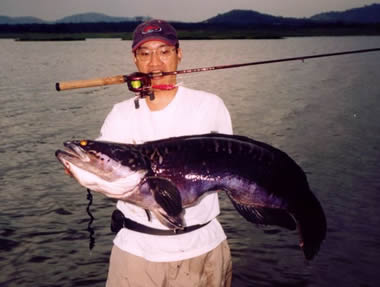
I backed off the drag a bit, just in case. It jumped another time, an amazing feat for such a big toman. By this time it was beginning to tire and Pat had the landing net out. We had it beside the canoe a few times, but each time we tried to bring it to the net it had enough energy to dive back down. The other problem we had was that the toman was big and getting it into the net would take some doing. In the end with difficulty we had the big toman in the net, safely landed.
We got to the nearest bankside to calm down and get things organised, like getting the well embedded tail hook of the deep red Tilsan Barra out of the upper jaw. Pat later claimed that I was so excited that I probably could not remember my name. Now with it safely on the shore I pulled out a spring scale to weigh the toman and it bottomed out the scale, which meant including the weight of the net, it weighed over 10 kilos! That indicated this monster was definitely over 9 kilos, far exceeding our expectations! Pat suggested we stop fishing and go back to the car to weigh, measure and take pictures of the fish according to the IGFA requirements.
So we put the big toman in the inadequately sized box filled with water, with its tail sticking out, and paddled back to the car. The certified scale we had with us could weigh a maximum of 10 kg, and when we weighed it, it went off the scale! This toman was heavier than 10 kilos!
In our wildest dreams we had never anticipated such a catch, and thus did not have the heavier scale. We guessed that the toman would have weighed maybe 10.2 kilos, but to qualify for such a submission, we had to get the fish to a certified scale that had the measurement for that weight. We decided to be satisfied with a slight reduction in actual weight for the record submission, as we wanted to release the fish back into the lake if we could.
Now for myself, the bar has been set so high I doubt that I will ever see a toman that big again. It was a catch of a life time, but as Patrick said, "who knows, this may not be the last", though I would be very surprised to see a toman even close to that double digit figure on my line again.
A week later, on our National Day, I was fishing with Neoh and Peter, using my boat. With the three of us, it made it easier to get the boat to the water from the car. On the water, I picked up my rod loaded up with 2 kilo line and pulled on the double and surprisingly the line broke! It was quite scary to realise how fragile these lighter lines are. Not wanting to waste time retying the double and leader. I picked up my spin outfit rigged with 1 kilo line and used that instead.
Since catching the monster toman, we had not caught any fish on the following trips and that day, the conditions did not look like improving. Therefore I was surprised to get a hook up on a cast to a rise. With 1 kilo line, the drag was set extremely light and the toman blazed its way all over the place. This one behaved like a sail, jumping a lot! Neoh said he had never seen a toman behave like that, going airborne again and again! Five minutes of very light drag later, we had this specimen netted and in the box of water, safely kept alive. We weighed it later according to IGFA regulations before releasing it, and it weighed 2.2kgs.
After an hour of very hard casting, Neoh managed to get a hook up on 2 kilo line, which unfortunately broke off a few seconds later at a knot. I believe I might have cinched down that knot too tight, thus weakening it. It was another reminder on the importance of careful preparation that is needed with light lines. It was fortunate that the monster toman had not been taken on tackle with any such weaknesses.
Since that day, we have not been able to get the toman to bite at all! The toman near the city had become cunning again and refused to be enticed to our luring. However my memory of the "once in a lifetime" 10+ kilo toman will be forever etched in my memory, and the Tilsan barra lure that caught this fish has been retired to solely a display role!
This IGFA world record was made on the 23rd of August 2009 and to date, more than four years later, it still holds the 3kg line class record and the all tackle world record for snakehead species.
Conservation
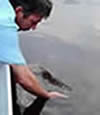
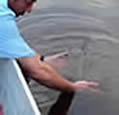
We need to protect and conserve our resources by practising catch and release of our sportfish and protecting the habitat of our fishes.
